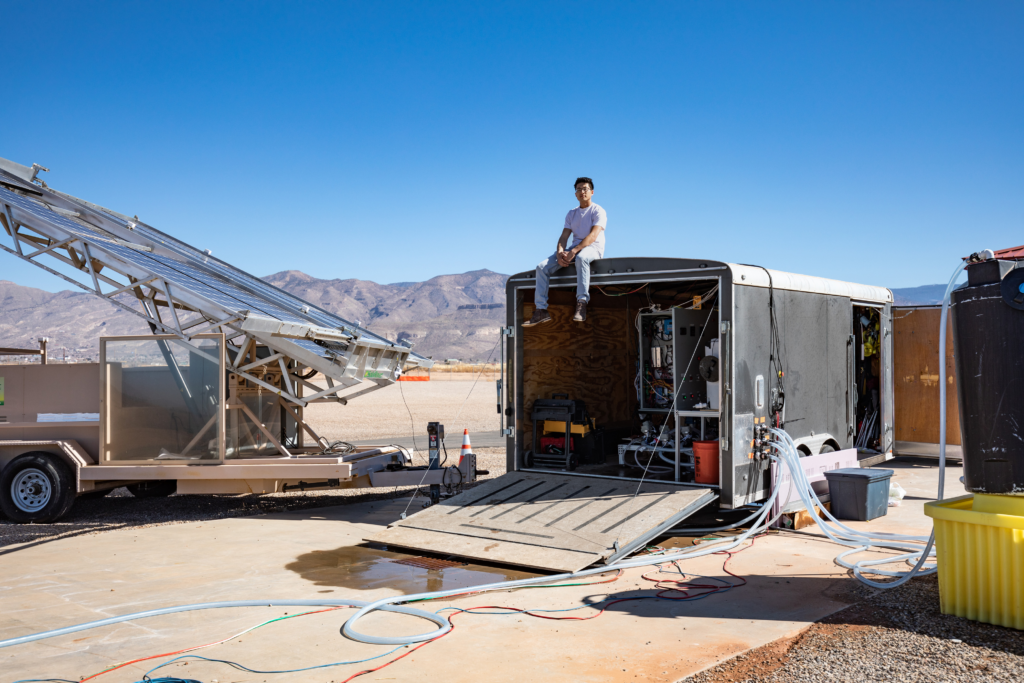In a groundbreaking development, MIT researchers have introduced a solar-powered desalination system that removes salt from water without the need for batteries or external power sources. This innovation is poised to offer a cost-effective and sustainable solution to the global freshwater crisis, especially in regions with high water stress, such as India, North Africa, and the Middle East.
How the Solar Desalination System Works
The system employs a technique called electrodialysis, where an electric field separates salt ions from water by passing it through specialized membranes. What’s particularly innovative about this system is its ability to adjust water flow and voltage according to the available sunlight. This is made possible by flow-commanded current control, a method that responds to changes in solar power 3-5 times per second. As a result, the system can operate without needing energy storage solutions like batteries, maximizing the use of solar energy in real-time.
Benefits of the System
- Maximized Solar Energy Use: The system’s rapid response to sunlight variations ensures that it efficiently uses available solar power to produce clean water. By avoiding the need for batteries, the system reduces overall costs while maintaining high water production.
- Cost-Effective: Traditional desalination methods often require expensive infrastructure and significant energy inputs, making this battery-free approach a more economical alternative. The system is ideal for areas with brackish groundwater—less salty than seawater—which significantly reduces energy consumption compared to seawater desalination.
- Ideal for High Water-Stress Regions: Many regions experiencing water shortages, particularly those with ample sunlight, can benefit from this system. These include arid areas like India, the Middle East, and North Africa, where clean water access is critical for survival and economic development.
Limitations and Challenges
While the system excels in processing brackish water, it may not be as efficient when applied to seawater desalination. Seawater requires more energy to desalinate due to its higher salt concentration. As the system evolves, researchers will need to refine its energy efficiency and adaptability for a wider range of water sources.
Future Advancements
MIT’s next steps involve enhancing the system’s control mechanisms to further improve its response times to sunlight fluctuations and boost overall energy efficiency. With these advancements, the system could become even more practical and scalable for widespread use in various environments, making it an essential tool in the fight against water scarcity.

Concrete Solutions to Save Our Planet
The MIT-developed battery-free solar desalination system represents a remarkable advance in the fight against global water scarcity, offering a sustainable and scalable alternative to conventional, energy-intensive desalination processes. By using solar energy to purify water, this innovation could alleviate the water shortages affecting many regions worldwide. To fully leverage the potential of this technology, several strategic actions must be pursued:
Increased Investment: Governments, international agencies, and private companies must prioritize funding in research, development, and the global deployment of solar desalination technologies. Investment in this sector will help expand these systems to water-scarce regions, providing relief to areas that rely heavily on unsustainable water sources.
Localized Implementation: Smaller, decentralized desalination units can be implemented in rural or remote areas with limited infrastructure. By delivering clean drinking water to these isolated communities, this technology could transform lives, particularly in regions plagued by chronic droughts or seasonal water shortages.
Public-Private Partnerships: Collaborations between governments and private entities are essential to speeding up the adoption and scaling of solar desalination systems. Such partnerships can pool financial resources, technological expertise, and operational capacity to ensure the deployment and upkeep of these systems, maximizing their societal impact.
Integration with Agriculture: By combining solar desalination with agricultural irrigation, farmers can access a sustainable and reliable water source for crops, even in drought-prone regions. This integration could reduce dependence on diminishing groundwater supplies, strengthen food security, and mitigate the impacts of climate change on agricultural production.
Continued Research: The ongoing refinement of solar desalination is critical to enhancing the energy efficiency, scalability, and affordability of the technology, especially for seawater desalination. Governments and research institutions must continue to allocate resources to push the boundaries of this innovation, ensuring it becomes a mainstream solution.
With these targeted measures, solar desalination technology could be a game-changer in addressing the global water crisis. Its development promises not only to alleviate immediate water shortages but also to support sustainable economic growth and create a more equitable distribution of water resources in the face of climate change.

Conclusion
MIT’s battery-free solar desalination system represents a groundbreaking innovation in the search for sustainable water solutions, particularly for regions grappling with severe water scarcity. This system harnesses the power of the sun to purify water without relying on traditional, energy-intensive desalination methods, making clean water more accessible while significantly reducing the environmental footprint of water management. By eliminating the need for external power sources, this technology opens up new possibilities for addressing the global water crisis in remote and underserved communities where access to clean water is scarce and infrastructure is limited.
The broader implications of this development are immense. As climate change exacerbates droughts, depletes freshwater reserves, and alters weather patterns, the need for alternative water solutions becomes more urgent. Technologies like MIT’s solar desalination system could play a vital role in safeguarding water resources for future generations by offering a renewable, low-cost alternative to energy-intensive methods such as reverse osmosis or thermal desalination, which rely heavily on fossil fuels. This shift towards cleaner water production aligns with global efforts to reduce greenhouse gas emissions and combat climate change.
To maximize the potential of this innovation, substantial investments are needed in both research and large-scale deployment. Governments, businesses, and international organizations must come together to fund and promote this technology, enabling it to reach regions that stand to benefit the most from clean, sustainable water solutions. Scaling up the production and distribution of solar desalination units can provide immediate relief in water-stressed areas, particularly in rural communities and regions vulnerable to climate-induced water shortages.
Collaboration across sectors is crucial to the success of solar desalination and other sustainable water technologies. Public-private partnerships can accelerate the implementation of such systems by leveraging the expertise, financial resources, and networks of various stakeholders. Furthermore, integrating solar desalination into broader water management strategies, including agricultural irrigation and urban water supplies, can enhance water security and contribute to sustainable development.
Continued research and development will be essential in refining the efficiency and affordability of solar desalination technologies. Enhancements in materials, energy storage, and system scalability will further decrease costs, making this solution accessible to a wider range of communities and industries. By fostering innovation, governments and academic institutions can ensure that this technology evolves in response to the changing demands of a rapidly warming world.
In summary, MIT’s battery-free solar desalination system is a beacon of hope for regions struggling with water scarcity. By embracing and investing in such transformative technologies, humanity can take meaningful steps towards protecting vital water resources and addressing the global environmental challenges that threaten the planet’s future.
Related Content
- MIT unveils battery-free solar desalination device with 77%
- Global Water Resources Crisis: WMO Report Urges Immediate Action to Combat Climate-Induced Water Shortages
- Green Hydrogen: A Brighter Future Fueled by Sunlight and Water?
- The Water-Powered Car Revolution: A Game-Changer for the Auto Industry and the Environment
- How Climate Change Will Disrupt Water Resources in France
- Kamala Harris vs Donald Trump: A Watershed Moment for America’s Environmental Future
- Safer Fertilizers from Wastewater Sludge
- MIT engineers develop solar-powered desalination system
- Solar-Powered Desalination System Brings Clean Water

